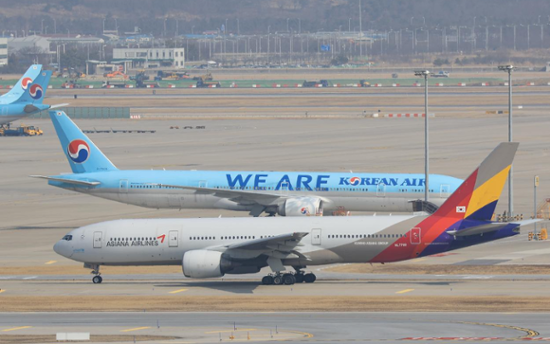
Korean Air and Asiana Airlines passenger jets are parked on a runway at Incheon International Airport in this Feb. 13 photo. Yonhap
Jeju Air, Jin Air, T’way to see double-digit profit falls
By Lee Min-hyung
Korea’s major airlines are projected to suffer a drastic fall in earnings in the second quarter. They are hit hard by escalating pressure to cut fares and a string of other unfavorable macroeconomic factors, including the strengthening dollar, according to data and analysts, Tuesday.
Most low-cost carriers (LCCs) are forecast to experience a double-digit decline in their operating profits during the same period due to intensified competition to woo more customers for short-distance routes.
This drove them to cut airfares even at the cost of their profitability. LCCs and flag carriers, such as Korean Air, also face growing operating expenses due to rising labor and fuel costs.
The won-dollar exchange rate also poses a lingering financial burden to airlines, as they have to pay fuel costs in dollars. The exchange rate on Tuesday hovered at 1,385.5 won per dollar.
Data also indicate that most carriers will likely report a steep fall in earnings for the April to June period due to multiple risk factors.
According to data from market tracker, FnGuide, Jeju Air is estimated to have chalked up an operating profit of 15.8 billion won ($11.4 million) during the second quarter, down 36.2 percent from the previous year. The company is the nation’s largest LCC by market capitalization.
Other LCCs also face a similar fate. Jin Air is forecast to have generated 13.9 billion won in operating profit during the same period, down 22.3 percent.
T’way Air will be hit hardest as it had to increase spending to prepare for its expansion in routes to Europe after Korean Air transferred four of its European routes to the LCC as part of a precondition to win approvals for its long-awaited takeover of Asian Airlines.
Taking into consideration the expanded expenditure, the forecast for T’way Air’s operating profit reached merely 4.8 billion won, down 76.1 percent, according to the market tracker.
Korean Air, however, appears to have fared relatively well despite the challenging market conditions thanks to its solid air cargo business.
The flag carrier is estimated to have attained an operating profit of 468 billion won in the second quarter, down merely 1.93 percent from a year earlier.
“The overall decline in airfares across the aviation industry still raises concerns that Korean Air’s earnings peaked out,” Jung Yeon-seung, an NH Investment & Securities analyst, said.
“The company is unlikely to improve its profitability in the second quarter, as its operating expenses are increasing due to rising labor and fuel costs.”
Other analysts also painted a pessimistic outlook on the second-quarter earnings for LCCs here.
“The second quarter is typically the off-season for LCCs as their sales are heavily reliant on air routes to Japan and Southeast Asia,” Hana Securities analyst Ahn Do-hyun said.
“But LCCs’ earnings in the second quarter display less significance due to the seasonal factor.”
Reflecting on the gloomy earnings outlook, shares of most carriers have lost steam for a rebound for the past few weeks. Shares of Korean Air reached a three-month high of 23,950 won per share on June 27 but have since declined to close at 21,100 won per share on Tuesday. Other LCCs also showed a similar trajectory in their stock price movement this month.
